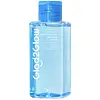What's inside
What's inside
 Key Ingredients
Key Ingredients

No key ingredients
 Benefits
Benefits

 Concerns
Concerns

 Ingredients Side-by-side
Ingredients Side-by-side

Water
Skin ConditioningHexylene Glycol
EmulsifyingPEG-7 Glyceryl Cocoate
EmulsifyingNiacinamide
SmoothingDecyl Glucoside
CleansingButylene Glycol
HumectantPropanediol
SolventPhenoxyethanol
PreservativeMannitol
HumectantGlycerin
HumectantXylitol
HumectantAllantoin
Skin ConditioningCetrimonium Bromide
AntimicrobialPanthenol
Skin ConditioningPropylene Glycol
HumectantSalicylic Acid
MaskingCucumis Sativus Fruit Extract
EmollientEthylhexylglycerin
Skin ConditioningPotassium Hydroxide
BufferingCentella Asiatica Extract
CleansingBiosaccharide Gum-2
Skin ConditioningTetrasodium EDTA
Caprylic/Capric Triglyceride
MaskingPotassium Azeloyl Diglycinate
Skin ConditioningDeoxyphytantriyl Palmitamide Mea
Skin ConditioningHydrogenated Lecithin
EmulsifyingCeramide NP
Skin ConditioningCholesterol
EmollientPotassium Chloride
Caprylyl Glycol
EmollientChlorphenesin
AntimicrobialWater, Hexylene Glycol, PEG-7 Glyceryl Cocoate, Niacinamide, Decyl Glucoside, Butylene Glycol, Propanediol, Phenoxyethanol, Mannitol, Glycerin, Xylitol, Allantoin, Cetrimonium Bromide, Panthenol, Propylene Glycol, Salicylic Acid, Cucumis Sativus Fruit Extract, Ethylhexylglycerin, Potassium Hydroxide, Centella Asiatica Extract, Biosaccharide Gum-2, Tetrasodium EDTA, Caprylic/Capric Triglyceride, Potassium Azeloyl Diglycinate, Deoxyphytantriyl Palmitamide Mea, Hydrogenated Lecithin, Ceramide NP, Cholesterol, Potassium Chloride, Caprylyl Glycol, Chlorphenesin
Ingredients Explained
These ingredients are found in both products.
Ingredients higher up in an ingredient list are typically present in a larger amount.
Chlorphenesin is a synthetic preservative. It helps protect a product against bacteria in order to extend shelf life. In most cases, Chlorphenesin is paired with other preservatives such as phenoxyethanol and caprylyl glycol.
Chlorphenesin is a biocide. This means it is able to help fight the microorganisms on our skin. It is also able to fight odor-releasing bacteria.
Chlorphenesin is soluble in both water and glycerin.
Studies show Chlorphenesin is easily absorbed by our skin. You should speak with a skincare professional if you have concerns about using Chlorphenesin.
Learn more about ChlorphenesinPanthenol is a common ingredient that helps hydrate and soothe the skin. It is found naturally in our skin and hair.
There are two forms of panthenol: D and L.
D-panthenol is also known as dexpanthenol. Most cosmetics use dexpanthenol or a mixture of D and L-panthenol.
Panthenol is famous due to its ability to go deeper into the skin's layers. Using this ingredient has numerous pros (and no cons):
Like hyaluronic acid, panthenol is a humectant. Humectants are able to bind and hold large amounts of water to keep skin hydrated.
This ingredient works well for wound healing. It works by increasing tissue in the wound and helps close open wounds.
Once oxidized, panthenol converts to pantothenic acid. Panthothenic acid is found in all living cells.
This ingredient is also referred to as pro-vitamin B5.
Learn more about PanthenolPropylene Glycol is an odorless, colorless liquid. As a humectant, it helps skin retain moisture. It also aids in delivering active ingredients.
Another role of this ingredient is preventing a product from melting or freezing. Propylene glycol also adds antimicrobrial properties to a product, elongating product lifespan.
This ingredient is considered an organic alcohol and commonly added into both cosmetics and foods.
Those with sensitive skin or conditions may develop a rash when using this ingredient.
Learn more about Propylene GlycolWater. It's the most common cosmetic ingredient of all. You'll usually see it at the top of ingredient lists, meaning that it makes up the largest part of the product.
So why is it so popular? Water most often acts as a solvent - this means that it helps dissolve other ingredients into the formulation.
You'll also recognize water as that liquid we all need to stay alive. If you see this, drink a glass of water. Stay hydrated!
Learn more about Water